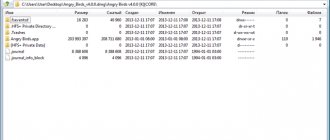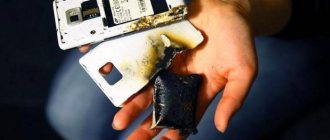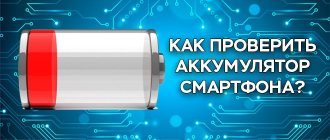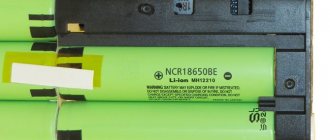A modern person cannot imagine his life without a mobile phone, tablet, laptop, portable drill, screwdriver, flashlight and other devices that can operate either from the mains or from a battery. Often, such devices use lithium-ion power sources.
Many will ask why this type of energy storage device is most often used in electrical appliances. The answer is quite simple and obvious - lithium-ion batteries are small in size, and they also have a fairly long service life - from 300 to 2000 charge-discharge cycles. Precisely because there are so many power sources of this type around us, every person should know how to charge a lithium-ion battery.
What is Li-ion battery
Despite the fact that every person has encountered such a power source, not everyone understands what kind of battery it is and how it works. The simplest and most common option is a lithium-ion power supply for mobile phones. It has the following design: on top there is a controller for charge-discharge control, and below is a battery element (bank).
99% of cell phone batteries use only one battery cell; in their jargon, experts often call it a can. The nominal voltage of this power supply is 3.7 volts.
The device also has a special controller (a regular board with a microcircuit), thanks to which the battery does not overcharge. Therefore, the manufacturer, for its part, did everything possible to ensure that no emergency situations occurred that would lead to a quick breakdown of the power source.
How long to charge a lithium battery
The battery charging time is determined by the process of capacity restoration. A distinction is made between full and partial charge.
Capacity is measured in ampere hours. This means that if you apply a charge numerically equal to the capacitance, then within an hour the required voltage will be created at the terminals, and the energy reserve will be 70-80%. If the capacity is measured in units of C, a current of 1C-2C should be applied when fast charging. Fast charging time is about an hour.
For a full charging cycle of batteries from several cells connected in series, 2 stages are used - CC/CV. The CC stage lasts until a voltage equal to the operating voltage appears at the terminals, in volts. Second stage: at a stable voltage, current is supplied to the jar, but with increasing capacity, it tends to zero. Charging time takes about 3 hours, regardless of capacity.
How to charge for the first time
Many probably remember how everyone said that a new battery must be completely discharged, and then fully charged, and this must be done three times.
There really is such a process of first charging, it is actually necessary, but for Ni-Cd and Ni-MH batteries. Such batteries were installed in quite ancient telephones, which are now practically not produced. Not everyone knows how to properly charge a lithium-ion battery for the first time and begins to carry out the procedure of completely discharging it. Batteries of this type are designed completely differently, and the process of deep discharge is very harmful to them. That is why such devices are sold with a charge of 2/3 of the capacity, and not so that a person can check a phone or other device.
Unfortunately, quite often consumers, before charging a lithium-ion battery for the first time, remembering the old days, begin to completely discharge it, thereby almost immediately taking away half of their service life. Therefore, be careful and avoid common mistakes that lead to battery failure.
Security measures
The elements themselves, assembled using lithium ion technology, are quite safe. The times when such a battery could explode in your hands under heavy load are in the past. The exception is recent events, when one well-known manufacturer promoted an ultra-fast charging system for its phones for marketing purposes. But certain safety measures must be observed.
- It is strictly forbidden to charge disposable lithium cells, i.e. primary batteries. For example, in the 14500 form factor (for a regular AA battery) both batteries and batteries of the Li-SOCl2 system are produced. They have very similar markings. You should always make sure that it is the battery that will be charged;
- Do not try to disassemble a lithium battery or puncture and release pressure from a “swollen” element (the pressure valve is faulty). Fire is unlikely, but strong heating and leakage of electrolyte is almost certain;
- When charging with multifunctional chargers with manual setting of parameters, it is prohibited to supply a voltage of more than 5 volts to the li ion without protective boards (for example, internal banks of mobile phones). High risk of battery fire. With such a charge on a cylindrical element (any of them has a protective mechanical plate), it will simply fail;
- When traveling by air, it would not hurt to clarify the rules for transporting batteries. Nowadays, it is usually allowed to carry batteries exclusively in the cabin (not in luggage) inside a particular piece of equipment. The policy for transporting replacement (spare) batteries needs to be clarified;
- If electrolyte gets on your skin, you must rinse the area under running water.
Under design operating conditions, lithium-ion batteries are a reliable and durable source of energy. Using original chargers and giving preference to a charge mode of 10-20% residual charge, you can significantly extend their service life. Today, this is the most widespread type of autonomous power supply, both in consumer electronics and industrial systems.
Li-ion battery 18650
This battery has a cylindrical shape and in appearance completely resembles a regular battery. It is worth noting that unscrupulous manufacturers, trying in every possible way to increase sales, begin to indicate inflated characteristics. Today there are no more energy-intensive 18650 Li-ion batteries than 3400 mAh. If a number greater than this is indicated on the battery, then it should be understood that the manufacturer is deliberately overestimating the characteristics of its product. In this case, there is a high probability that in fact the battery will have no more than 2200 mAh.
Can a lithium battery be charged using regular charging?
Two different battery systems—lithium and lead-acid—require different approaches to capacity restoration. Lead batteries are not as demanding on charging parameters as lithium ones. Yes, and the charging criteria are different.
To charge Li-ion, Li-pol in the first stage, constant current is required, in the second stage constant voltage is required. If you do not control the parameters at the first stage, overcharging is possible. But if the battery has built-in protection - BMS - it will cope. Therefore, you can even add some energy with a phone charger.
In a charger for lead batteries, the main indicator is stable voltage. For lithium chargers, a stable current is important at the first stage.
True, universal chargers have appeared that can be reconfigured for one or another charging mode. Here is the Russian development “Pendant”.
What are the dangers of overcharging and deep discharge?
Due to the fact that people do not know how to charge a lithium-ion battery, they often make mistakes and may keep it on charge for too long or, conversely, forget about it for a long time. What are the dangers of improper battery use? The thing is that in this case, lithium ions move from one electrode to another. The material used to make the electrodes themselves may vary, but in this topic these details are not so important.
Simply put, the more charged the battery, the more lithium ions are present in the electrode. If their value is constantly at the maximum, then in this case the device wears out quite quickly.
Charging characteristics
For charging lithium-ion batteries, two parameters are important:
- Charging current. In the battery, the charging current begins chemical reactions. The reactions vary from the amount of mass involved on the plates and its thickness, the surface of the electrodes, the thermal range, the unplanned process of electrolysis of water. A weak current does not activate the entire volume of electrode coating, but only its most superficial layer.
- Voltage. The voltage at the current terminals will not be higher than 12.5-12.6 Volts. Only specialists can fully charge such batteries. The operating voltages of a modern battery, below which it is not recommended to discharge 10.8 V and above which it is definitely impossible to raise when charging 14.4 V.
How to charge batteries
Li-ion batteries have also become very popular because there are quite a large number of options for how to charge them.
The most logical and correct way to charge a lithium-ion battery is with a standard charger. Thanks to a special device, the battery will receive maximum charge in the shortest possible time. Moreover, it is completely safe for the battery.
For those who do not know how to charge a lithium-ion battery if they do not have a standard charger at hand, we inform you that this can also be done using a computer and a USB cable. However, in this case, the current will reach only 0.5 amperes.
It is also possible to charge the Li-ion battery through the cigarette lighter in the car. Today, many stores sell special USB adapters that deliver different currents. It is best to find out what current to charge lithium-ion batteries in the documentation that comes with your phone, laptop or other device. The bulk of batteries are charged from 3.7 to 19 volts. However, there are battery models that require more or less voltage. In any case, you shouldn’t take risks, but it’s better to look at the instruction manual once again.
If none of the previous charging methods worked, you can use an old, but still relevant device to this day, which is popularly called “frog”. Such devices are mostly designed for cell phone batteries. The design of the “frog” is quite simple: there is one dock where a lithium-ion battery is installed, as well as contacts that are adjustable in width. Thus, this charger is suitable for almost any battery of this type.
As you can see, there are a lot of ways to charge a battery. But before you charge a lithium-ion battery, you should make sure that it really is not possible to use standard charging. Other methods are used if necessary. They do not harm the battery, but still the original charge should be a priority over the others.
If a person does not know how to charge the lithium-ion battery of a screwdriver, then we inform you that this should only be done with the specialized charger that comes with the device. It is worth noting that if the charger fails and it is not possible to purchase a new one, for example, this model is no longer produced, then in this case you can connect several 18650 batteries together and insert them into the box with the original charger. It is impossible to say how many 18650 batteries are needed, it all depends on the voltage of the screwdriver.
Parameters of typical battery cells
Finally, as background information, we present the official characteristics of the same popular Sanyo UR18650W2 battery cells that were mentioned above:
| minimum / typical capacity, mAh | 1500 / 1600 |
| rated voltage, V | 3,7 |
| minimum voltage, V | 2,75 |
| charging method | CC-CV (constant current then constant voltage) |
| maximum charging voltage, V | 4,2 |
| charging current, A | 1,5 |
| charging time, h | 2,5 |
| maximum continuous discharge current, A | 15 |
| temperature during charging, degrees. | 0 — +40 |
| working temperature | -20 — +60 |
| storage temperature | -20 — +50 |
—
Lower orange line – operation at -20°C.
Well, to be sure that the Sanyo UR18650W2 are not some kind of exception to the general rule, let’s lay out their 10 A discharge graph in comparison with two other batteries produced by Samsung and AW:
Calibration
Calibration is necessary approximately once every three months.
To do this, allow the battery to completely discharge. In this case, the battery controller will be able to independently calibrate the limits of the full charge and discharge of the device. This is necessary so that the device in which the Li-ion battery is installed displays up-to-date information about its charge. If the battery has not been completely discharged for a long time, unreliable information about the battery percentage may be displayed. After the battery is completely discharged, it must be fully charged to 100% with the device turned off. You can see the battery charging time in the instructions. If at the end of this time you turn on the device and the charge shows less than 100%, then you need to turn it off again and continue charging until the charge level is full.
Operation of Li─Ion batteries
Now let's briefly talk about the basic rules for operating lithium-ion batteries.
Calibration
This procedure should be carried out once every 3 months. It consists of completely discharging and then fully charging the battery. This must be done so that the battery controller “calibrates” the battery charge and discharge boundaries.
Calibrating a lithium-ion battery
When calibrating manually, you need to wait until your phone, tablet or other gadget turns off.
Then, with the device turned off, put the device on charge. You can check the duration until fully charged in your passport. Then remove and insert the battery, turn on the device and check the charge level. If it is less than 100%, then turn off the device and charge again. This must be done until the full charge level is shown when turned on. For calibration, you can also use utilities that exist for iOS and Android.
If you are interested in converting a screwdriver to use 18650 lithium batteries, you can read the article at the link.
Storage
Before storing a lithium-ion battery, it also needs to be charged. But the charge level should be about 50 percent. This is considered the optimal value. The battery storage temperature should ideally be 15 degrees Celsius. In such conditions, a lithium battery retains capacity best. The higher the storage temperature, the greater the loss of capacity during storage.
During long-term storage, once every three months, fully charge and discharge the battery and charge it again to 50%.
What not to do with lithium-ion batteries?
- The first thing that Li─Ion batteries cannot tolerate is heat. Lithium is an extremely reactive metal and when heated, an uncontrollable reaction can begin in the battery. As a result, the battery will simply ignite. Therefore, do not keep the Li─Ion battery near heat sources, under sunlight or near an open fire;
- Lithium-ion batteries are also sensitive to negative temperatures, but there are no such dire consequences as when heated. The battery simply loses its charge in the cold;
- Do not disassemble the battery cell. Depressurization of the battery can can lead to fire;
- Also, you should not charge the battery bank bypassing the controller. An exception can be made in cases where you need to push the battery. In this case, you need to take all precautions and constantly monitor the process.
Now you know how to charge a lithium-ion battery and the rules for its operation. If the article was useful to you, please share the link to it on social networks. This will help the development of the site. Vote in the poll below and rate the material! Please leave corrections and additions on the topic in the comments.
Storage
If you do not plan to use the battery for a long period of time, you should pay special attention to how it should be stored. The optimal charge is considered to be 30-60% of the capacity. The battery should be located in a fairly cool room where the air temperature remains around 15 degrees. If the battery is stored in a fully charged state, then the next time you turn it on you will find that its capacity has decreased significantly.
When the device is left completely discharged, it is even worse. With a high degree of probability, in six months it will need to be recycled. Lithium-ion batteries should not be stored for long periods of time in deep discharge.
Features of use
As we have seen, the characteristics are very good, but to ensure them it is necessary to follow the rules for operating lithium-ion batteries. Let's consider the main nuances of the correct use and maintenance of elements of this type.
How to charge
Lithium-ion batteries are charged using different algorithms, but the classic one is the following:
- If the battery is very discharged, charging occurs at a voltage of 2.9 V and a current of 0.1 C (a tenth of the capacity).
- When the voltage reaches 2.9 V at the battery terminals, the charging current increases to 0.4-0.3 C.
- As soon as the element is charged to 3.9-4.0 V, the current again decreases to 0.1-0.05 C, and charging continues until the voltage at the terminals reaches 4.2 V.
Expert opinion
Alexey Bartosh
Specialist in repair and maintenance of electrical equipment and industrial electronics.
Ask a Question
Important! Lithium cells can support fast charging mode with 1C current, but there is no need to abuse this mode - it shortens the battery life.
Well, when servicing Li-ion batteries, you must take into account that they cannot be overcharged. At best, an overcharged battery will lose capacity or fail; at worst, it may catch fire. To prevent this from happening, special controllers are built into the elements that disconnect the battery from the charger if the voltage at its terminals exceeds 4.2 V or the case temperature reaches 45 degrees Celsius.
It is worth noting that such controllers are not built into all batteries. Laptops, for example, use 18650 batteries without controllers. One common controller is responsible for charging them, and at the same time balancing (more on this below). Therefore, before using a battery, you need to find out for sure whether it has its own controller.
Is it possible to completely discharge
Lithium batteries have one more quirk - they cannot withstand deep discharge. When the terminal voltage drops below 2.3 V, the cell capacity decreases significantly, and if this is done regularly, the battery can be thrown away in a month.
So, sit with a voltmeter and constantly monitor the discharge level? Not at all. The same controller that makes sure that overcharging does not occur (see above) also controls the degree of discharge. If the cell voltage drops below 2.5 V (usually 2.8 V), the circuit will simply turn off the load.
But even to such a value you should not discharge Li-ion. Up to a maximum of 10% of capacity - and it’s time to charge. This will significantly extend the battery life. Most phones, smartphones and tablets discharge their batteries to this level. At the same time, they warn the user about the low charge, and if there is no reaction, they simply turn off. So, in principle, we have no problems with the use of lithium - everything is done by electronics.
Important. Only “smart” gadgets monitor the state of their battery. If we plug elements without a controller into a “stupid” flashlight, problems may arise. But here there will be no one to blame.
Why might it explode?
The first batteries, the anode of which was made of lithium metal, were literally explosive. Upon reaching the maximum number of charge/discharge cycles, and often before, a short circuit between the electrodes occurred. And since Li-ion is a fairly energy-intensive element, it immediately became very hot and either caught fire or exploded.
The problem was solved by replacing lithium with graphite, but if used incorrectly, problems can also occur with modern elements. Almost all batteries of this type are afraid of mechanical damage, which can cause a short circuit between the electrodes. They should not be overheated and, of course, overcharged above normal.
All this can cause fire and explosion. Moreover, a lithium battery burns no worse than thermite and without access to oxygen. You can’t fill it with water or cover it with a cloth. Below is a video confirming that you can foolishly break a battery.
Expert opinion
Alexey Bartosh
Specialist in repair and maintenance of electrical equipment and industrial electronics.
Ask a Question
All these troubles can happen only due to improper use or stupidity. It's a miracle that no one was hurt. If you use the element as expected, then in this regard it is quite safe. The only exception can be marriage, but, alas, no one is immune from this.
How to connect batteries
We figured out the separate battery. Now let's find out how they can be connected into a battery and why this should be done. If we want to increase the capacity, then we simply connect the individual elements in parallel. In this case, the capacity of such a lithium battery will be equal to the sum of the capacities of the elements.
Nothing complicated, but even with this inclusion you need to follow some rules:
- All batteries must have the same capacity and preferably be from the same batch.
- All elements must have a built-in controller. If they do not have controllers, then you need to use an external one that can provide the necessary current to simultaneously charge all batteries.
If we need to increase the output voltage, then the elements will have to be connected in series. In this case, the battery capacity will be equal to the capacity of the “weakest” battery, and the output voltage will be equal to the sum of the voltages on each element.
There are certain rules here too:
- All batteries must have the same capacity and preferably be from the same batch.
- Instead of a controller, you need to use a special BMS board that will monitor the state of each element individually. Moreover, the board must be designed for the required number of elements (cells).
Why do you need such a board with balancing? It monitors, as mentioned above, the condition of each battery individually. If any battery discharges below normal, the entire battery will be disconnected from the load. If it charges up to normal, then only it will be disconnected from the charger, the rest will continue to charge. This allows you to avoid overcharging and overdischarging each of the elements.
Now about the labeling of ready-made batteries that are commercially available. In particular, many are interested in what 3s2p and similar designations mean? Everything is simple here. The number before the P symbol shows how many batteries in each cell are connected in parallel. And the number after the symbol S is how many cells are connected in series. The picture below explains the above quite well.
That is, if the battery assembly says 3S2P, it means that it has 3 batteries connected in series and two such circuits are connected in parallel. And 4S4P - 4 in series and 4 in parallel. The required voltage is obtained by connecting several elements in series, and the required capacity is obtained by parallel connection. Let's say you have 12 batteries with a capacity of 3000 mAh, then the 4S3P assembly will have the following parameters: nominal voltage - 4x3.7V = 14.8V, and capacity - 3000 mAh x 3 = 9000 mAh. In this case, the maximum voltage of a fully charged assembly will be about 4.2Vx4=16.8V, and the minimum voltage of a completely discharged assembly will be 2.5Vx4=10V.
Lithium-ion battery protection
Above we mentioned several times the protection of Li─Ion batteries. Let's summarize all the information.
Lithium batteries use a field-effect transistor to open the circuit when the cell voltage rises to 4.3 volts. Thermal protection disconnects the circuit when the battery heats up above 90 degrees Celsius. You can also find a fuse in lithium-ion batteries that trips when the pressure in the housing increases to 1034 kPa. Circuits are also installed that protect the element from deep discharge. Their purpose is to break the circuit when the element voltage drops to 2.5 volts.
How does battery protection work?
The protection circuit for the lithium-ion battery when the phone is turned on has a resistance of 0.05-0.1 Ohm. These are two keys that are connected in series. The first is designed to operate at the upper, and the second ─ at the lower value of the battery voltage. Resistance doubles the internal resistance of the battery. The battery delivers maximum current with low internal resistance. The protection circuit is designed as an obstacle to an uncontrolled increase in current (both charging and discharging) of the battery.
Also, the protection scheme can be implemented using chemical additives. Manganese is used for this. In such batteries, instead of a protection circuit, only a fuse is installed. And all this does not affect safety. Manganese prevents the battery from overheating and igniting. Eliminating electronic circuitry reduces the price of lithium-ion batteries, but this creates another problem. The user can charge such a battery with a “non-native” charger. And in this case, it may happen that the charger does not stop the process when fully charged. Then, without a circuit, the battery will overcharge and fail. Such things end with bloating of the body.
How did lithium-ion batteries come about?
The very first battery cells with a lithium anode were released in the seventies of the last century. They had a high specific energy intensity, which immediately made them in demand. Experts have long sought to develop a source based on an alkali metal that has high activity. Thanks to this, the high voltage of this type of battery and energy density were achieved. At the same time, the development of the design of such elements was completed quite quickly, but their practical use caused difficulties. They were dealt with only in the 90s of the last century.
Over these 20 years, researchers have concluded that the main problem is the lithium electrode. This metal is very active and during operation a number of processes occurred that ultimately led to ignition. This came to be called flame-generating ventilation. Because of this, in the early 90s, manufacturers were forced to recall batteries produced for mobile phones. This happened after a series of accidents. At the time of the conversation, the current consumed from the battery reached its maximum and ventilation began with the emission of flames. As a result, there have been many cases of users suffering facial burns. Therefore, scientists had to refine the design of lithium-ion batteries.
Lithium metal is extremely unstable, especially when charging and discharging. Therefore, researchers began to create a lithium-type battery without using lithium. Ions of this alkali metal began to be used. This is where their name comes from.
Lithium ion batteries have lower energy density than lithium batteries. But they are safe if charge and discharge standards are observed.
Advantages and disadvantages
Lithium ion batteries have their advantages and disadvantages over other batteries. The advantages include such points as:
- high level of energy intensity;
- the memory effect is so minimal that it is practically absent;
- service life is very long;
- there is no need to further discuss the battery;
- performs its functions correctly over a wide temperature range;
- The self-discharge level is very low.
Despite all the advantages, lithium-ion batteries also have their disadvantages, for example:
- possibility of spontaneous combustion and explosion, swelling and failure;
- capacity decreases at operating temperatures below zero;
- the cost of the product is significantly higher than that of previous batteries;
- to increase the safety of using the device, a charge controller is required;
- does not tolerate deep discharge well.
By the way, most of the disadvantages are stopped. For example, if you wish, you can find a battery with a controller, which already eliminates the possibility of overheating and spontaneous combustion. And with constant recharging, deep discharge is also eliminated. Manufacturers also release more advanced versions of lithium-ion batteries every year. The shortcomings are gradually being eliminated and will soon perhaps completely disappear, which will make this type perfect.
Lithium-ion battery design
According to their design, Li─Ion batteries are made in cylindrical and prismatic designs. The cylindrical design represents a roll of electrodes with separator material to separate the electrodes. This roll is placed in a housing made of aluminum or steel. The negative electrode is connected to it.
The positive contact is output in the form of a contact pad at the end of the battery.
Cylindrical lithium-ion battery
Li-Ion batteries with a prismatic design are made by stacking rectangular plates on top of each other. Such batteries make it possible to make the packaging more dense. The difficulty lies in maintaining the compressive force on the electrodes. There are prismatic batteries with a roll assembly of electrodes twisted into a spiral.
Prismatic lithium-ion battery
All lithium-ion batteries are designed with measures to ensure their safe operation. This primarily concerns the prevention of heating and ignition. A mechanism is installed under the battery cover that increases the resistance of the battery as the temperature coefficient increases. When the pressure inside the battery increases above the permissible limit, the mechanism breaks the positive terminal and the cathode.
In addition, to increase operating safety, Li-Ion batteries must use an electronic board. Its purpose is to control the charge and discharge processes, to prevent overheating and short circuits.
There are many prismatic lithium-ion batteries currently being produced. They find application in smartphones and tablets. The design of prismatic batteries can often differ between different manufacturers, since they do not have a single unification. Electrodes of opposite polarity are separated by a separator. For its production, porous polypropylene is used.
The design of Li-Ion and other types of lithium batteries is always sealed. This is a mandatory requirement, since leakage of electrolyte is not allowed. If it leaks, the electronics will be damaged. In addition, the sealed design prevents water and oxygen from entering the battery. If they get inside, they will destroy the battery as a result of a reaction with the electrolyte and electrodes. The production of components for lithium batteries and their assembly takes place in special dry boxes in an argon atmosphere. In this case, complex techniques of welding, sealing, etc. are used.
As for the amount of active mass of a Li-Ion battery, manufacturers are always looking for a compromise. They need to achieve maximum capacity and ensure safe operation. The following relation is taken as a basis:
Ao / An = 1.1, where
Ао – active mass of the negative electrode;
An is the active mass of the positive electrode.
This balance prevents the formation of lithium (pure metal) and prevents fire.
History of appearance
The first lithium ion battery was released in 1991. The leading company in the production of this type of battery is Sony. But batteries were developed in the 70s. These were the first devices with high energy intensity, which made them popular. But it was not possible to apply them practically on a mass scale.
The battery contains two electrodes. The cathode is placed on aluminum foil, and the anode is placed on copper foil. They are separated by a special separator, which consists of a liquid electrolyte, in some cases a gel-like material. Positive charges are carried by lithium ions. They have a way of penetrating other materials and chemical elements, which provokes an electrochemical reaction. With this property, they provide charge or power to devices (phones, laptops, etc.).
In the early years after the creation of lithium-ion storage devices, they were known to be explosive. This was due to the use of lithium metal in the design of the storage device, as well as due to the formation of chemical compounds in the form of gas. With a large amount of discharge and charge, a short circuit occurred, which resulted in an explosion of the battery.
Explosions also occurred because lithium ions reacted with other compounds and substances in the battery. The reaction was dangerous and entailed the release of a large amount of heat, after which the battery caught fire and exploded. During the improvement, it was decided to replace the anode with a graphite analogue. This castling made it possible to eliminate the problem with the explosion hazard of the battery. And after identifying a flaw, the manufacturer had to recall the entire batch of mobile phones.
Interesting fact ! The chargers through which the drives receive a charge have a function to prevent battery overheating and protection against “overflow” of current.
It took more than 20 years of active research and improvement to develop a completely safe lithium-ion battery. This led to the release of a more innovative type of battery, namely lithium phosphate. They do not overheat, and there are no components with dangerous reactions to each other. Also, many manufacturers build a controller into the case for charging batteries to avoid incidents with fire.
Design
The design of a lithium-ion battery depends on the type of device for which it is intended. A mobile phone uses a battery called a “jar”. It has a rectangular shape and includes one structural element. Its nominal voltage is 3.7 V.
The presented type of battery for a laptop has a completely different design. There may be several individual battery cells in it (2-12 pieces). Each of them has a cylindrical shape. These are Li-Ion 18650 batteries. The manufacturer of the equipment indicates in detail how to charge them correctly. This design includes a special controller. It looks like a microcircuit. The controller controls the charging procedure and does not allow the battery's rated capacity to be exceeded.
Modern batteries for tablets and smartphones also provide a charge control function. This significantly extends the battery life. It is protected from various adverse factors.
Reactions occurring in a Li─Ion battery
A breakthrough in the direction of introducing lithium-ion batteries into consumer electronics was the development of batteries in which the negative electrode was made of carbon material. The carbon crystal lattice was very suitable as a matrix for the intercalation of lithium ions. To increase the battery voltage, the positive electrode was made of cobalt oxide. The potential of lite cobalt oxide is approximately 4 volts.
The operating voltage of most lithium-ion batteries is 3 volts or more. During the discharge process at the negative electrode, lithium is deintercalated from carbon and intercalated into cobalt oxide of the positive electrode. During the charging process, the processes occur in reverse. It turns out that there is no metallic lithium in the system, but its ions work, moving from one electrode to another, creating an electric current.
Reactions on the negative electrode
All modern commercial models of lithium-ion batteries have a negative electrode made of carbon-containing material. The complex process of intercalation of lithium into carbon largely depends on the nature of this material, as well as the substance of the electrolyte. The carbon matrix at the anode has a layered structure. The structure can be ordered (natural or synthetic graphite) or partially ordered (coke, soot, etc.).
During intercalation, lithium ions push the carbon layers apart, inserting themselves between them. Various intercalates are obtained. During intercalation and deintercalation, the specific volume of the carbon matrix changes insignificantly. In addition to carbon material, silver, tin and their alloys can be used in the negative electrode. They are also trying to use composite materials with silicon, tin sulfides, cobalt compounds, etc.
Reactions on the positive electrode
Primary lithium cells (batteries) often use a variety of materials to make the positive electrode. This cannot be done in batteries and the choice of material is limited. Therefore, the positive electrode of a Li─Ion battery is made of lithiated nickel or cobalt oxide. Lithium manganese spinels can also be used.
Research is currently underway on mixed phosphate or mixed oxide materials for the cathode. As experts have proven, such materials improve the electrical characteristics of lithium-ion batteries. Methods for applying oxides to the cathode surface are also being developed.
The reactions that occur in a lithium-ion battery during charging can be described by the following equations:
positive electrode
LiCoO2 → Li1-xCoO2 + xLi+ + xe—
negative electrode
С + xLi+ + xe— → CLix
During the discharge process, reactions go in the opposite direction.
The figure below schematically shows the processes occurring in a lithium-ion battery during charging and discharging.
Reactions occurring in a Li-Ion battery
What is not allowed when charging a phone battery
All batteries, without exception, do not tolerate:
- hypothermia;
- overheating;
- blows and other physical damage;
- sudden change in temperature;
- use of non-native memory;
- permanent connection to the power grid.
Depending on the type, they also have some other “predilections”.
With li-ion battery
The following should not be allowed with this type of battery:
- frequent complete discharge;
- constant 100% charge;
- storage in a discharged state;
- too frequent charge calibration;
- overheating and hypothermia.
It’s better to keep the battery charge up to 90%, and do a “training session” every few months, and everything will be fine.
With li-pol battery
The following should not be allowed with this type of battery:
- full discharge;
- training or calibration;
- full charge;
- permanent connection to the power grid;
- overheating and hypothermia.
Just like with li-on, the optimal charge will be in the range from 20 to 90%.
With ni-mh battery
The following should not be allowed with this type of battery:
- recharge;
- frequent charge “little by little”;
- storage fully charged or completely discharged;
- overheat.
In order not to lose the capacity of such a phone, it is recommended to charge it completely and discharge it as much as possible. “Train” periodically.











